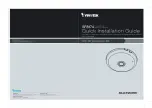
BSR 2000 Configuration and Management Guide
Release 1.0
10-2
MGBI
526360-001-00 Rev. B
About RIP
Routing Information Protocol (RIP) is an Interior Gateway Protocol (IGP) that uses
distance-vector routing to measure the shortest path between two points on a network.
Distance-vector routing requires that each router inform its neighbors of its routing
table. For each network path, the receiving router selects the neighbor advertising the
lowest cost, and adds this entry to its routing table for re-advertisement. A host using
RIP should have interfaces to one or more networks, which are known as directly
connected networks.
RIP uses broadcast User Datagram Protocol (UDP) data packets to exchange routing
information. RIP listens for these broadcasts on UDP port 520. The BSR uses the
advertising process to send routing information updates every 30 seconds. If a router
does not receive an update from another router for 180 seconds, it marks the routes
served by the non-updating router as unusable. If the router does not receive an update
after 300 seconds, it removes all routing table entries for the non-updating router.
RIP uses the hop count to rate the value of different routes. A directly connected
network has a hop count of one; an unreachable network has a hop count of 16. This
small range of metrics makes RIP unsuitable for large networks.
The route tag field in a RIP message allows boundary routers in an autonomous
system (AS) to exchange information about external routes. Route tags separate
internal RIP routes from external RIP routes that were imported from an Exterior
Gateway Protocol (EGP) or another IGP. Routers that support protocols other than
RIP should allow configuration of route tags for routes imported from different
sources.
The subnet mask field in a RIP (RIPv2 only) message contains the subnet mask
applied to the IP address to set the non-host portion of the address. If the subnet mask
field is not used, the subnet mask is calculated. On an interface where a RIPv1 router
operates on information in a RIPv2 routing entry, the following rules apply:
■
Information internal to one network must never be advertised to another network.
■
Information about a more specific subnet may not be advertised where RIPv1
routers would consider it a host route.
■
Supernet routes (routes where a netmask is less specific than the natural network
mask) must not be advertised where they could be misinterpreted by RIP routers.
The next hop field in a RIP (RIPv2 only) message contains the next destination IP
address. A value of zero in this field indicates that the next destination is the origin of
the RIP message to reduce unnecessary load on hosts that do not listen to RIPv2
messages. RIP update packets use IP multicast address 224.0.0.9.
Summary of Contents for BSR 2000
Page 1: ...BSR 2000 Configuration and Management Guide 526360 001 00 Rev B Release 1 0 MGBI ...
Page 6: ... Motorola Motorola Motorola Motorola Motorola Motorola Motorola Motorola Motorola ...
Page 50: ......
Page 130: ......
Page 164: ......
Page 458: ......
Page 490: ......
Page 580: ......
Page 632: ......
Page 648: ......
Page 649: ......
Page 650: ...526360 001 00 Rev B 7 06 MGBI Visit our website at www motorola com ...
















































